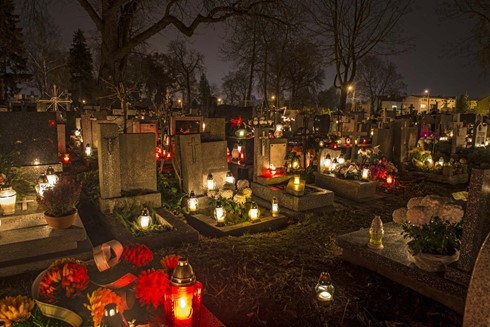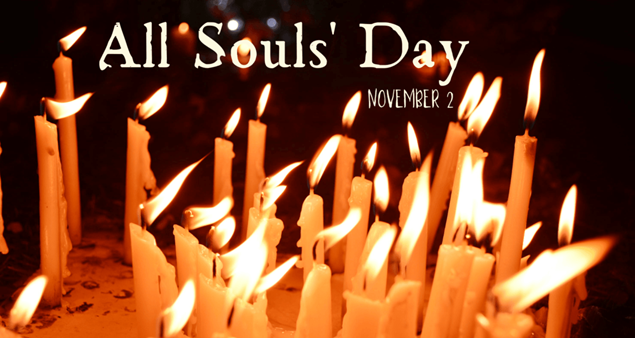
All Saints’ Day, is celebrated every year on November 1st by the Roman Catholic Church.
In Trinidad and Tobago it is a common sight to see people belonging to other religious faith observing All Saints’ Day by visiting the graves of their deceased relatives, leaving offerings of flowers and lighting candles in remembrance of their dearly departed loved ones.
Most people however, light candles in memory of their deceased loved ones on November 2nd which is known as All Souls’ Day.
But, how many of us have actually given any thought to the origin of the observance of All Day Saints or All Souls Day in our country?
The following article written by Professor Angelo Bissessarsingh provides the answer to this question.
THE HISTORY OF THE EARLIEST OBSERVANCE OF ALL SAINTS DAY IN TRINIDAD.

The diverse potpourri of our culture means that even a staid and solemn occasion like the observance of All Saints’ Day or All Hallows Day cannot remain mundane for long.
The earliest observance of commemorating the souls of the departed was in 1592, when the first Roman Catholic Church was founded at San Jose de Oruna (St Joseph).
From all accounts, the early Spanish inhabitants of the island were zealous in celebration of the multitude of feast days associated with the Church of Rome and All Hallows Day would have been among them.
With the influx of French settlers and their slaves following the Cedula of Population in 1783, the tradition would have continued. At the time Port-of-Spain was served by two burial grounds—one on the present site of Columbus Square and the other called the Campo Santo (Holy Field) where Mahatma Gandhi Square on Phillips Street now exists.
The cleaning of the graves of loved ones would have been part of the activity as well as the lighting of candles. In those days there was no public maintenance of the cemeteries and each clan had to be responsible for its own plot.
The coming of the French saw the occasion being called L’Toussaint, by which name it is still known in some quarters of society.
When Lapeyrouse Cemetery was formally laid out and established in 1813, sections were designated along colour and class lines, with a separate division for Anglicans being consecrated in 1823. This does not mean, however, that L’Toussaint remained the enclave of the Catholics, since other denominations observed the formalities as well.
Aside from a simple cleaning of the gravesite, those who could afford the luxury chose this as the opportunity to place headstones or renovate existing markers, even with just a coating of white limewash.
One observer in 1865 recorded that a majority of the graves in Lapeyrouse were unmarked, with the intentions of the relatives of the deceased not answering to their means, so that a number of plots were mere tumuli of earth that were kept clean and beautified with the planting of flowering ixora and hibiscus cuttings.
Sometimes a simple wooden cross was added with the name and age of the departed. In San Fernando and Arima—the other two towns of consequence—it is supposed that All Saints’ traditions were observed as well, especially in the latter settlement, where there was a strong Catholic presence and an ancient cemetery dating back to the 1790s.
In San Fernando, two previous town graveyards had been closed and a new one opened on the lands of the old Paradise sugar estate in 1868.
This, aptly called Paradise Cemetery, was a model of neatness, having several shady samaan trees overhead and the sections clearly demarcated by wide paths that were later paved with asphalt, making them the first paved roads in the colony.
One problem that arose here in the 1880s was that the cemetery, around L’Toussaint, was occupied by rowdy hoodlums from the lower-income areas near Coffee and Medine Streets.
These miscreants undertook to harass the families of the town who had turned out to care for the last resting places of their dead. The gangs showed no regard even for the esteemed and respected Fr Andre Violette of the Our Lady of Perpetual Help RC church on Harris Promenade, who came out to pray for the souls.
A stern remonstrance by Fr Violette had no impact on the reprobates, so that henceforth, the borough council undertook to have a policeman stationed in the cemetery on the two nights required for the customary activities and this brought a measure of peace.
Before 1868, Indo-Trinidadians were in the habit of interring their dead in their gardens or else in the estate cemeteries where they were in indentured bondage. The Rev John Morton, who founded the Presbyterian Church’s Canadian Mission to the Indians (CMI) in that year, made a formal appeal to the borough to have a piece of Paradise Cemetery designated for Christian, Muslim and Hindu Indians and this was granted in 1869. As a result, both converted and unconverted Indo-Trinidadians began following the traditions of All Saints’ Day.
Up until the 1940s, these observances were treated as minor national festivals and hardware stores would advertise funerary decorations in anticipation, but this seems to be a measure of respect for the memories of our ancestors that has vanished, since the current L’Toussaint is but a ghost of its former self.
What Is All Souls’ Day?

It was during the Middle Ages that Christianity came to England and Ireland. As it became more widespread, its traditions started to blend with the Pagan traditions of the Celtics, and in 1000 A.D., a new holiday was born.
The Christian church created All Souls’ Day, which adopted some of the Celtic traditions of Samhain—a Gaelic festival marking the end of the harvest season and the beginning of the “darker half” of the year. Celebrations also included masquerades and bonfire celebrations.
Celebrating In Silence

Today, a popular way to celebrate All Souls’ Day is with prayer.
Masses are often offered for the benefit of the dead, and many churches have the custom of asking parishioners to write the names of their lost loved ones in a book called the “Book of the Dead” or “Book of Remembrance.”
These names are remembered during all masses and church services celebrated during the month of November.
Other All Souls’ Day customs include cleaning and visiting gravesites and decorating cemeteries with lighted candles. Some families even cook their loved one’s favorite meal and place it on their graves.
All Souls’ Day Beliefs, Legends, Lore
When it comes to All Souls’ Day, people of faith around the world hold extraordinary beliefs and traditions about spirits on this day:
- In the Mexican culture, All Souls’ Day is known as Día de los Muertos or the Day of the Dead.
It is believed that the dead are still members of the community, kept alive in memory and spirit, and during the Day of the Dead, they temporarily return to Earth.

The 2017 animated movie, Coco, depicted the Día de los Muertos traditions.
- According to Hungarian tradition, all work and housework is forbidden on All Souls’ Day. It is seen as disrespectful to the dead, and it is believed that any work done will be sabotaged by them.
- According to a superstition from the Philippines: When it rains on All Souls’ Day, the raindrops are tears of the dead.
- Many cultures decorate with candlelight because they believe it warms the dead and helps souls find their way back to their graves at the end of All Souls’ Day.
- According to the teachings of the Catholic Church, Catholics can shorten the time a soul spends in purgatory (a place where souls are purified before entering heaven) by visiting a church and praying the Our Father and the Creed on All Souls’ Day.
Do you participate in any All Souls’ Day celebrations?